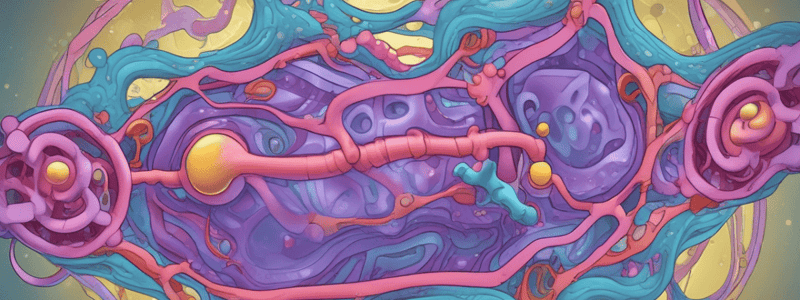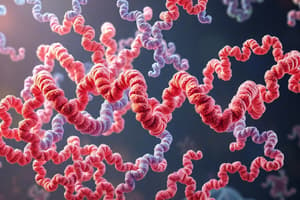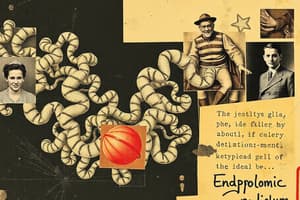Podcast
Questions and Answers
What is the function of signal recognition particle (SRP)?
What is the function of signal recognition particle (SRP)?
- It recognizes and binds to the nuclear localization signal
- It recognizes and binds to the lysosomal membrane
- It recognizes and binds to the signal sequence and to the ribosome (correct)
- It recognizes and binds to the mitochondrial membrane
What type of proteins are targeted for the ER by cotranslational translocation?
What type of proteins are targeted for the ER by cotranslational translocation?
- Most lysosomal proteins
- Most ER lumen proteins (correct)
- Most mitochondrial matrix proteins
- Most Golgi apparatus proteins
What is the function of oligosaccharide transferase in the ER?
What is the function of oligosaccharide transferase in the ER?
- It adds glycosyl groups to asparagines in the nascent protein (correct)
- It removes glycosyl groups from the nascent protein
- It targets proteins for the lysosomal membrane
- It recognizes and binds to the signal sequence and to the ribosome
What is the importance of glycosylation in protein processing?
What is the importance of glycosylation in protein processing?
What is the role of chaperones in the ER?
What is the role of chaperones in the ER?
What is the consequence of incorrect protein folding in the ER?
What is the consequence of incorrect protein folding in the ER?
Where do chaperones bind to polypeptides in the mitochondria?
Where do chaperones bind to polypeptides in the mitochondria?
What is the process by which soluble materials in the extracellular fluid are taken up and incorporated into vesicles for digestion?
What is the process by which soluble materials in the extracellular fluid are taken up and incorporated into vesicles for digestion?
Where are proteins sorted for transport to lysosomes, plasma membrane, or secretion from the cell?
Where are proteins sorted for transport to lysosomes, plasma membrane, or secretion from the cell?
What is the function of Nuclear Localization Signal (NLS) in protein sorting?
What is the function of Nuclear Localization Signal (NLS) in protein sorting?
What is the characteristic of mitochondrial and chloroplast membranes?
What is the characteristic of mitochondrial and chloroplast membranes?
What is the process by which proteins are transported to the mitochondrial matrix?
What is the process by which proteins are transported to the mitochondrial matrix?
What is the function of the signal sequence in amino acid sequence in protein sorting?
What is the function of the signal sequence in amino acid sequence in protein sorting?
What is the role of the trans Golgi network in protein sorting?
What is the role of the trans Golgi network in protein sorting?
What is the characteristic of proteins that pass through the Golgi apparatus?
What is the characteristic of proteins that pass through the Golgi apparatus?
What is the primary function of peroxisomes?
What is the primary function of peroxisomes?
Which pathway is responsible for the transport of proteins to the extracellular environment?
Which pathway is responsible for the transport of proteins to the extracellular environment?
What is the characteristic of the chemical environment in the ER and Golgi apparatus?
What is the characteristic of the chemical environment in the ER and Golgi apparatus?
Which proteins are translocated simultaneously into the mitochondrial matrix?
Which proteins are translocated simultaneously into the mitochondrial matrix?
What is the purpose of chaperone proteins in protein transport?
What is the purpose of chaperone proteins in protein transport?
Which organelles are involved in the secretory pathway?
Which organelles are involved in the secretory pathway?
What is the characteristic of mitochondrial matrix proteins?
What is the characteristic of mitochondrial matrix proteins?
Which proteins are synthesized on free ribosomes?
Which proteins are synthesized on free ribosomes?
What is the term for the process by which cells engulf and internalize external substances through the formation of vesicles?
What is the term for the process by which cells engulf and internalize external substances through the formation of vesicles?
What is the term for the process by which molecules are released from the cell through the fusion of secretory vesicles with the plasma membrane?
What is the term for the process by which molecules are released from the cell through the fusion of secretory vesicles with the plasma membrane?
What is the function of the endomembrane system in eukaryotic cells?
What is the function of the endomembrane system in eukaryotic cells?
What is the term for the process by which cells take in fluids and macromolecules through the formation of small vesicles?
What is the term for the process by which cells take in fluids and macromolecules through the formation of small vesicles?
What is the function of lysosomes in eukaryotic cells?
What is the function of lysosomes in eukaryotic cells?
What is the term for the movement of molecules across membranes through the use of electrochemical potential?
What is the term for the movement of molecules across membranes through the use of electrochemical potential?
What is the function of the Golgi apparatus in eukaryotic cells?
What is the function of the Golgi apparatus in eukaryotic cells?
What is the term for the process by which molecules are transported across membranes through selective channels?
What is the term for the process by which molecules are transported across membranes through selective channels?
What is the function of calreticulin in the ER?
What is the function of calreticulin in the ER?
What happens to misfolded proteins retained in the ER?
What happens to misfolded proteins retained in the ER?
What is the mechanism known as ER-associated degradation (ERAD)?
What is the mechanism known as ER-associated degradation (ERAD)?
How do single-pass transmembrane proteins (TMPs) pass through the phospholipid bilayer?
How do single-pass transmembrane proteins (TMPs) pass through the phospholipid bilayer?
What is the characteristic of multipass transmembrane proteins (TMPs)?
What is the characteristic of multipass transmembrane proteins (TMPs)?
What is the function of the trans-Golgi network?
What is the function of the trans-Golgi network?
What is the purpose of the Golgi apparatus?
What is the purpose of the Golgi apparatus?
What is the orientation of ER transmembrane proteins established during?
What is the orientation of ER transmembrane proteins established during?
What is the role of chaperones in the ER during protein synthesis, and how do they prevent incorrect protein folding?
What is the role of chaperones in the ER during protein synthesis, and how do they prevent incorrect protein folding?
How does the cell respond to misfolded proteins retained in the ER?
How does the cell respond to misfolded proteins retained in the ER?
What is the difference between single-pass and multipass transmembrane proteins (TMPs) in terms of their topology?
What is the difference between single-pass and multipass transmembrane proteins (TMPs) in terms of their topology?
What is the mechanism by which proteins are targeted for the ER by cotranslational translocation?
What is the mechanism by which proteins are targeted for the ER by cotranslational translocation?
What is the role of calreticulin in the ER, and how does it relate to calcium binding?
What is the role of calreticulin in the ER, and how does it relate to calcium binding?
What is the significance of protein glycosylation in the ER lumen, and how does it relate to protein folding?
What is the significance of protein glycosylation in the ER lumen, and how does it relate to protein folding?
How do chaperones facilitate protein folding in the ER, and what is the consequence of incorrect folding?
How do chaperones facilitate protein folding in the ER, and what is the consequence of incorrect folding?
What is the purpose of the translocon complex in the ER, and how does it relate to protein synthesis?
What is the purpose of the translocon complex in the ER, and how does it relate to protein synthesis?
What happens to misfolded proteins retained in the ER?
What happens to misfolded proteins retained in the ER?
What is the role of calreticulin in the ER?
What is the role of calreticulin in the ER?
How do single-pass transmembrane proteins (TMPs) pass through the phospholipid bilayer?
How do single-pass transmembrane proteins (TMPs) pass through the phospholipid bilayer?
What is the characteristic of multipass transmembrane proteins (TMPs)?
What is the characteristic of multipass transmembrane proteins (TMPs)?
What is the function of the trans-Golgi network?
What is the function of the trans-Golgi network?
When are ER transmembrane proteins' orientation established?
When are ER transmembrane proteins' orientation established?
What is the role of chaperones in protein folding, and how do they interact with polypeptides in the ER?
What is the role of chaperones in protein folding, and how do they interact with polypeptides in the ER?
What is the mechanism of ER-associated degradation (ERAD), and how does it contribute to protein quality control?
What is the mechanism of ER-associated degradation (ERAD), and how does it contribute to protein quality control?
Describe the orientation of ER transmembrane proteins established during translation, and how does this orientation influence their function?
Describe the orientation of ER transmembrane proteins established during translation, and how does this orientation influence their function?
What is the role of calreticulin in the ER, and how does it interact with calcium ions?
What is the role of calreticulin in the ER, and how does it interact with calcium ions?
How do proteins synthesized on free ribosomes differ from those translated on ER-bound ribosomes?
How do proteins synthesized on free ribosomes differ from those translated on ER-bound ribosomes?
What is the characteristic of multipass transmembrane proteins (TMPs), and how do they interact with the phospholipid bilayer?
What is the characteristic of multipass transmembrane proteins (TMPs), and how do they interact with the phospholipid bilayer?
What is the purpose of the trans-Golgi network (TGN) in protein sorting, and how does it differ from the cis-Golgi network?
What is the purpose of the trans-Golgi network (TGN) in protein sorting, and how does it differ from the cis-Golgi network?
What is the role of signal sequences in protein targeting, and how do they influence protein sorting and localization?
What is the role of signal sequences in protein targeting, and how do they influence protein sorting and localization?
What is the primary function of hydrophilic and hydrophobic passageways in solute transport across membranes?
What is the primary function of hydrophilic and hydrophobic passageways in solute transport across membranes?
What is the role of electron transport proteins in mitochondria?
What is the role of electron transport proteins in mitochondria?
What is the characteristic of the cell membrane that allows it to be flexible and fluid?
What is the characteristic of the cell membrane that allows it to be flexible and fluid?
What is the role of receptors in intercellular communication?
What is the role of receptors in intercellular communication?
What is the purpose of vesicles in cellular transport?
What is the purpose of vesicles in cellular transport?
What is the importance of selective permeability in cell membrane function?
What is the importance of selective permeability in cell membrane function?
What is the primary function of membrane transport?
What is the primary function of membrane transport?
Which type of receptors bind signaling molecules outside the cell and initiate physiological responses?
Which type of receptors bind signaling molecules outside the cell and initiate physiological responses?
What is the term for the simultaneous transport of two solutes in the same or opposite directions across the membrane?
What is the term for the simultaneous transport of two solutes in the same or opposite directions across the membrane?
What determines the permeability of a substance through the bilipid layer?
What determines the permeability of a substance through the bilipid layer?
Which class of receptors is characterized by the presence of an ion channel that opens and closes in response to chemical or mechanical signals?
Which class of receptors is characterized by the presence of an ion channel that opens and closes in response to chemical or mechanical signals?
What is the role of carrier proteins in membrane transport?
What is the role of carrier proteins in membrane transport?
What is the characteristic of Enzyme-linked receptors?
What is the characteristic of Enzyme-linked receptors?
What is the term for the protein that binds to GTP or GDP, depending on activation?
What is the term for the protein that binds to GTP or GDP, depending on activation?
What is the primary function of the cell membrane?
What is the primary function of the cell membrane?
What is the term for the fluid state of the phospholipid bilayer in the cell membrane?
What is the term for the fluid state of the phospholipid bilayer in the cell membrane?
What is the purpose of membrane enzymes?
What is the purpose of membrane enzymes?
What is the function of transport proteins in the cell membrane?
What is the function of transport proteins in the cell membrane?
What is the term for the molecules that allow cells to identify and interact with each other?
What is the term for the molecules that allow cells to identify and interact with each other?
What is the term for the lipids that make up the cell membrane?
What is the term for the lipids that make up the cell membrane?
What is the characteristic of the hydrophobic tail of a phospholipid?
What is the characteristic of the hydrophobic tail of a phospholipid?
What is the term for the type of lipid that has a sugar molecule attached to the glycerol backbone?
What is the term for the type of lipid that has a sugar molecule attached to the glycerol backbone?
What are the three major classes of Transmembrane receptors?
What are the three major classes of Transmembrane receptors?
What is the role of an amphipathic lipid in a phospholipid bilayer structure?
What is the role of an amphipathic lipid in a phospholipid bilayer structure?
Study Notes
Enzymes and Membrane Function
- Enzymes aid in identifying specific organelles and are involved in energy production in mitochondria, with electron transport proteins like cytochromes and iron sulphur proteins playing a crucial role.
- Solute transport across membranes occurs through hydrophilic and hydrophobic passageways, allowing for the transport of nutrients.
Cell Membrane Properties
- The cell membrane is a dynamic, non-rigid structure that allows for flexibility and fluidity due to its composition of ions and organic molecules.
- Vesicles are structures within or outside a cell, consisting of liquid or cytoplasm enclosed by a lipid bilayer, and are formed during secretion, uptake, and transport of materials within the plasma membrane.
Dynamism of Cell Membrane
- The fatty acid composition of the cell membrane can change, with unsaturated fatty acids and chain length affecting its properties.
- The cell membrane has selective permeability, allowing certain substances to pass through while restricting others, which is crucial for maintaining homeostasis and proper cellular function.
Membrane Transport
- Membrane transport involves the movement of solutes across the membrane, with a higher concentration of solutes inside organelles than outside.
- The major aspects of membrane transport include permeability of the molecule through the lipid bilayer and the availability of an energy source.
- There are two types of transport: primary active transport, which is directly driven by ATP hydrolysis, and secondary active transport, which is driven by the gradient power of another molecule.
Receptors
- Receptors bind signaling molecules outside the cell and initiate a physiological response, with transmembrane proteins being classified into three main types: ion channel receptors, G-protein coupled receptors, and enzyme-linked receptors.
- Ion channel receptors are multimeric proteins that form a passageway through the membrane, allowing specific ions to pass through.
- G-protein coupled receptors are specialized proteins that bind to GTP or GDP, depending on activation, and dissociate into two parts that interact with other membrane-bound proteins.
- Enzyme-linked receptors, such as receptor tyrosine kinases (RTKs), are the largest class of enzyme-linked receptors and are regulated by protein tyrosine phosphatase (PTP).
Cell Membrane Structure
- The cell membrane is composed of a phospholipid bilayer, embedded proteins, carbohydrates, and cholesterol.
- The fluid mosaic model describes the structure of the cell membrane, with proteins embedded in the lipid bilayer and carbohydrates attached to the surface.
Membrane Lipids
- Phospholipids are amphipathic lipids with a phosphate-based head group and a hydrophobic tail, consisting of phosphoglycerides, sphingolipids, and sterols.
- Glycolipids are composed of monosaccharides attached to glycerol, while sterols are multi-ring molecules related to cholesterol.
Studying That Suits You
Use AI to generate personalized quizzes and flashcards to suit your learning preferences.
Related Documents
Description
This quiz covers protein folding in the ER, including the role of calreticulin, ER-associated degradation, and the processing of ER transmembrane proteins.



